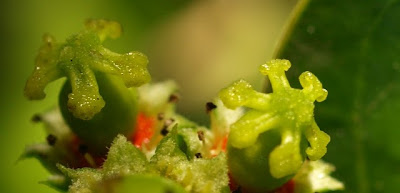Costa Rican Holly a hit in the African Tunnel Bed and Fantasyland
These are the female flowers of the Costa Rican Holly. For 50 years this species was known in much of the world from a description in a scientific journal and the gardens of Italy and North America. Meanwhile it was growing, and presumably known locally, in high mountains (more than 1500 metres above sea level) in Mexico and further south into Central America.
You'd assume by its common name that it grew naturally in Costa Rica but it's also called Puerto Rican Holly and apparently it doesn't grow there outside gardens. It does seem to extend to Guatemala at least, so the other commonly used name Guatemalan Holly has some credence.
Perhaps we better stick with the botanical name, Olmediella betschleriana. Not an easy one to remember but if it helps, Oldmediella because it looks a bit like Olmedia. Olmedia is an old name for something in the fig family so I'm presuming it's because of the fig-like fruits on our, let's call it, Central American Holly. There is only one species of Olmediella and that's named after a Dr Betschler, about whom (in true Colonel Clink fashion) I know nothing.
Like some of the hollies (Ilex) the leaves are not particularly holly-like. That is, they are mostly without the pointy protuberances, although you see a couple here and there. I gather, like true hollies, it varies from plant to plant.
It is dioecious - that is, an individual plant has only male or female flowers - and the flowers I've photographed from the Royal Botanic Gardens' African Tunnel Bed (more of that later) have a few straggly little male bits but they are strongly female (and fruit producing).
While the fruits remind me, and apparently Henri Baillon who named this genus in 1880, of figs, some sources say the fruits are the size of oranges, another the size of peaches. Not ours. They are more like walnuts, very small limes, or indeed figs. But perhaps this is not surprising. As a couple of our astute botanists discovered, none of our fruits seem to have seeds. In many plants fruits only develop fully when flowers are pollinated and given we have only two specimens of the Olmediella in the botanic gardens, and both are female, it's a fair bet they are always sterile.
This pseudo-holly has been grown in Italy for more than 100 years but appears to be less commonly elsewhere in Europe. It is popular though, at least among plant enthusiasts, in southern North American and Central American gardens: I gather you can find a few growing in Fantasyland at Disneyland, in California. And although cultivated since the 1850s, Olmediella was apparently only discovered in its native habitat in 1935. First in Guatemala, and then later in Mexico and Hunduras. Not Costa Rica I note!
It is not related to the true holly and quite an odd looking plant in flower. These days the genus is included with willows in the Salicaceae, rather than the old dumping ground for many homeless genera called the Flacourtiaceae.
And what's this African Tunnel Bed? On our visitor maps the garden is the site of the Southern Africa Collection. Clearly my Central American friend has no place in either of these categories, but that's often the way with botanic gardens - some plants linger and persist into new themes, others are so intriguing we keep them. In the last few decades the collection has morphed into one mostly South African derived, so the Director's Tunnel became the African Tunnel. The 'Tunnel' refers to the overarching vegetation across the path along western edge of the garden bed (near the pedestrian entrance to Gardens House, previously the Director's residence), an example it is said of a William Guilfoyle landscaping conceit where you pass through an enclosure to revelation beyond. I guess it's all a fantasy, but in a nice way.






Comments